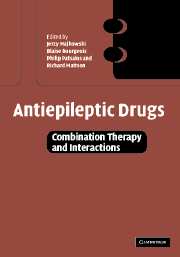Book contents
Foreword
Published online by Cambridge University Press: 07 September 2009
Summary
It is my special pleasure to introduce this book about the principles on which to base combination antiepileptic drug (AED) therapy and its related problems.
As reviewed in the excellent opening chapter by Mason and Routledge, therapeutic strategies involving the combination of different drugs are currently used to treat hypertension, infectious diseases and cancer in an attempt to enhance efficacy, reduce unwanted side effects and decrease the of probability of developing resistance. However, their disadvantages may exceed their benefits. First of all, drug toxicity may actually be increased by combination therapy as a result of negative pharmacodynamic interactions and the increased probability of idiosyncratic reactions. Secondly, the management of combination therapy is complicated by pharmacokinetic interactions. Thirdly, the risks of non-compliance and medication error are significantly greater with a multiple drug regimen.
How these general concepts apply to pharmacological antiepileptic therapy is dealt with by the most authoritative specialists in the first three parts of the book, which give considerable space to pharmacokinetic and pharmacodynamic interactions, while the fourth part develops these questions further with special regard to the patients' age, associated health problem (neurological or general), and sexual life (contraception, pregnancy, etc.). The reader is thus guided in understanding the rationale for combining AEDs, and made aware of the caveats that need to be taken into account.
In an ideal situation, we should consider AED combinations in such a way as to ensure that each pharmacological ingredient targets a specific epileptogenic mechanism.
- Type
- Chapter
- Information
- Antiepileptic DrugsCombination Therapy and Interactions, pp. xiii - xivPublisher: Cambridge University PressPrint publication year: 2005
- 1
- Cited by



